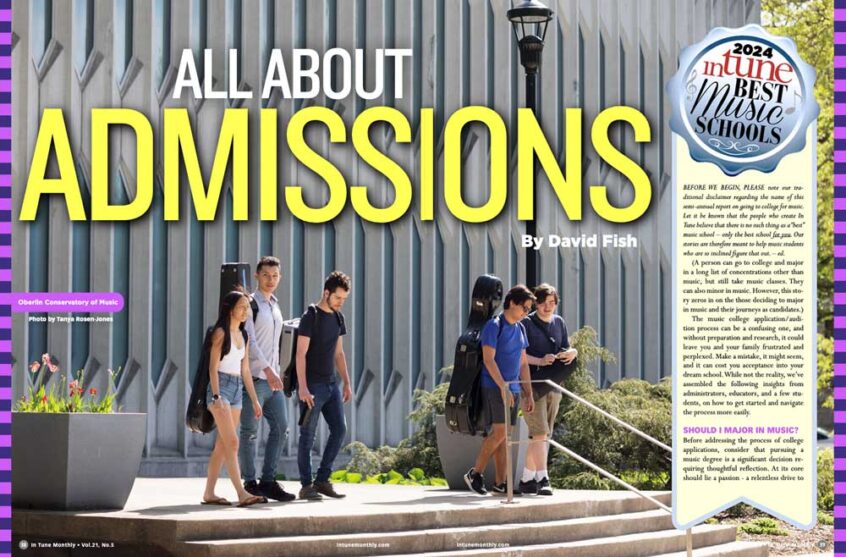Your Application
Having created a shortlist and visiting the schools on it, you’re now ready for the next phase of the admissions process: submitting applications. Pursuing a performance degree in music requires attentiveness when applying, which takes meticulous homework. Each school evaluates candidates through a unique lens – some emphasizing instrumental technique, others seeking
more holistic musicianship, including theory competency. Conducting thorough research is imperative. Examine the specific repertoire, scales, exercises, and sight reading required at each of your shortlisted colleges. This lets you strategically polish and demonstrate breadth across your musical capacities during auditions. You will find it helpful to create a spreadsheet for the application requirements for each school.
Applying for admission for non-performance pro- grams will require other research and the ability to convey other skills, experiences, and interests. Gath- er all of them and develop a familiarity with them so that you can easily articulate and demonstrate who you are, and what you’ve done.
Avoid Pitfalls
It sounds simple enough: don’t make mistakes. But college applications do demand care to sidestep stumbles. Double-check for accuracy, spelling, and typos. Use planners to track timelines and tasks and make sure you’re on top of deadlines. Music admissions professionals point to common hazards to avoid. “The biggest pitfall we see with some applicants is a failure to read all the details regarding the application process and audition or interview requirements we publish,” said Ryan Dearon and Josh Teaster of the Oberlin Conservatory of Music at Oberlin College.
Espen Jensen, Director of Admissions and Finan- cial Aid, Jacobs School of Music, Indiana University, points to another common mistake his school sees in music applications:
“(A) common pitfall is to forget that two applications are needed: one to Indiana University and the other to the Jacobs School of Music. The two work together, and it is a fairly seamless process. However, it is critical to take the necessary time to complete both before the deadline.
Surmani’s colleague at CSUN, Jeffrey Izzo, Mike Curb Endowed Chair of Music Industry Studies, reminds us in plain language that music is just one of the criteria for consideration in your application, “A low GPA, of course, never looks good.”
Emma Davis cautions against mixing up the school names. “We know you’re probably not just applying for our school but be careful to double-check the school’s name when filling out the application or writing emails to the admission office.” Beyond double-checking the school names on the application, it is im- important to demonstrate familiarity with the program when applying. Jodi Levitz, Professor of Viola and String Program Director at Frost School of Music, says students too often apply “without knowledge of the school and lack a reason as to why they wish to attend our particular school, and/ or study with its faculty.” On the other hand, Oberlin’s representatives point out easy ways to make your application stand out, “Since the application process for Oberlin Conservatory involves submitting screening ma- terials, the best way to stand out is to adhere to the deadlines and submit materials on time, preferably early.”
Preparing Your Application
Start early, noting all needed components from transcripts to portfolios or auditions for arts programs. And don’t become overwhelmed. Read all of the directions, and work on one part of an application at a time. Once one section is completed, rest and come back to it at another time. Applications were meant to allow students to present themselves. See them as puzzles and break them down as you might when learning a piece of music.
Create spreadsheets organizing requirements and deadlines for each target school. Account for essays, short answer length limits, topics, or special arts supplement prompts. Plan additional testing registrations if required. A visual tracker provides oversight, minimizing last-minute scrambles. After meeting each milestone, rigorously proofread every piece multiple times in the final stages, reading aloud to catch errors. Be sure to maximize uniqueness by conveying personality and passion. Seeking feedback from teachers and peers can help you prevent oversights.
Additional Requirements
Applications usually include additional questions beyond the main sections. This allows students to showcase their talents, traits, and passions. Some schools ask for resumes or provide space to list extracurricular activities or skills beyond academics, for example, club leadership, athletics, internships, and hobbies. This shows a well-roundedness. Colleges are also interested in your outlook, seeking student perspectives on what drives or inspires them. Responding requires self-reflection on those pivotal people, works, or experiences that relate to your personal growth. Writing about your life lessons, for instance, demonstrates your developing maturity and constant learning, two cornerstones of the collegiate journey.
The Common App
Depending on which schools you apply to, you may be directed to complete the Common Application. The Common Application (more commonly known as the Common App) is an undergraduate college admission application that candidates may use to apply to over 1,000 member colleges and universities in all 50 U.S. states and the District of Columbia, as well as in Canada, China, Japan, and many European countries.
Of the Common Application’s member institutions, about a third are “exclusive users” that use the Common Application as their only admissions application online or in print (listed https://www.commonapp.org/ explore/). If the member has a separate proprietary application, they are required to give equal consideration to applicants using either form as a condition of membership.

